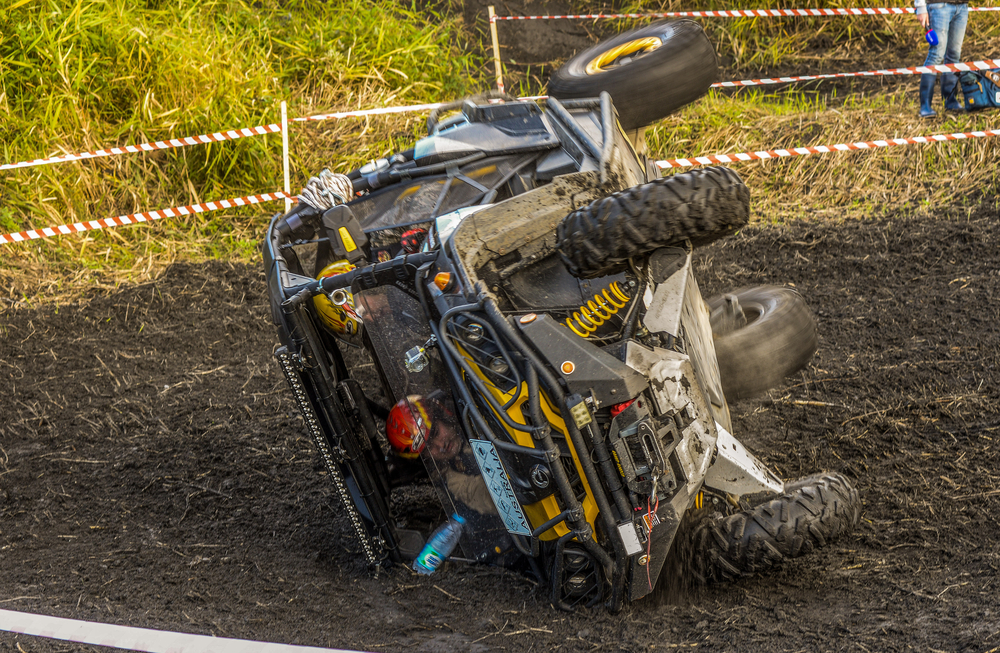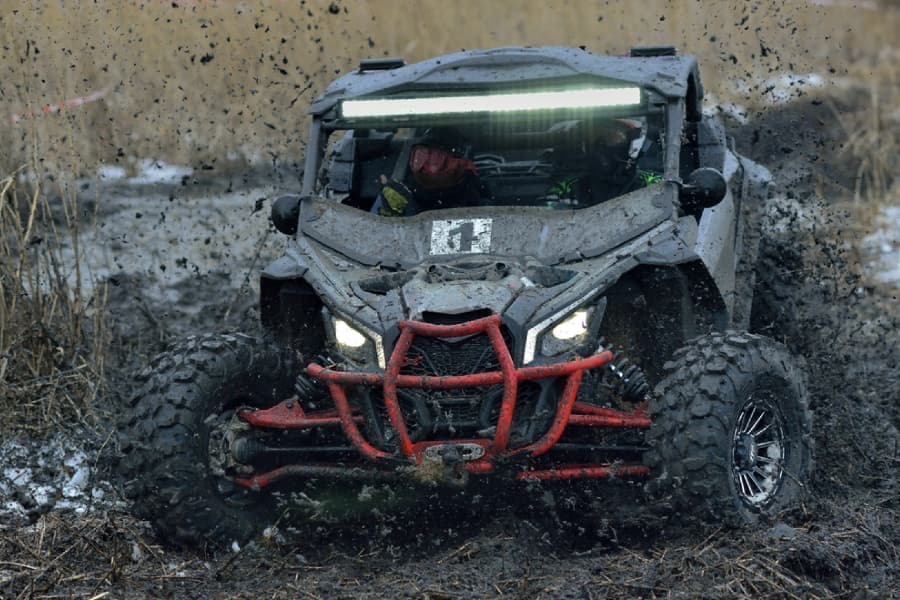All-terrain vehicles make it easy and fun to head out into the wild, skimming over hills and terrain that a standard car cannot handle. However, ATVs, side-by-side vehicles (SxS), and utility task vehicles (UTVs) have dangers that can increase the risk of injury to drivers and their passengers.
While knowing the dangers of side-by-side ATVs may help reduce the risk of serious injury or death, it's also important to recognize their inherent dangers, which can cause serious accidents no matter how careful you are as a driver or passenger.
Side-by-Sides: The Key Difference
ATVs, or all-terrain vehicles, are designed to travel off-road, over any terrain, including high-risk areas. Commonly referred to as quads or four-wheelers, these vehicles have an open design with limited safety features.
Some ATVs are designed for just a single passenger. However, a side-by-side vehicle, also known as a Utility Task Vehicle (UTV), features a more enclosed design with side-by-side seating for two or more occupants. These vehicles are built to traverse rugged terrains, including dirt and snow, facilitating group travel.
Side-by-sides may have the capacity to carry as many as six passengers, with seats situated in pairs. Depending on the terrain, side-by-sides can reach speeds of up to 60 miles per hour or more.
Safety Measures for Side-by-Side Vehicles
You can be the safest driver or passenger on an ATV, but it may still not be enough to protect you from the vehicle's inherent risks. However, understanding the risks associated with side-by-side vehicles can help mitigate some of the dangers. Consider the following safety measures:
- Wear Appropriate Safety Gear: Always wear helmets, seat belts, and protective clothing to reduce the risk of injuries if you have an accident.
- Undergo Proper Training: Ensure that you and all operators receive training to handle the vehicle safely.
- Regular Vehicle Maintenance: Frequently inspect and maintain your vehicle to identify and address potential defects and other issues.
- Adhere to Manufacturer Guidelines: Follow operational guidelines provided by the manufacturer.
Implementing these precautions can help reduce the chance of an accident and help you mitigate potential injuries if you are involved in a side-by-side rollover or crash.
Dangers of Side-by-Side ATVs
Side-by-side ATVs can pose several dangers and hazards. Due to their design, they can handle many types of terrain. However, rugged terrain can pose significant risks and cause severe injuries.
Driver error causes many ATV accidents. Sometimes, the design of side-by-side ATVs can also contribute to the risk of an accident.
Defective ATVs
The long list of ATV recalls shows us the potential hazards of defective ATVs and UTVs on the market. Common defects may include fire hazards from fuel leaks or overheating engines, brake problems, or mechanical problems with the construction of the vehicle,
These types of defects increase the risk of accidents and injuries. Many defective products remain on the market long before the Consumer Product Safety Commission realizes they pose a severe hazard. Unfortunately, too many people must suffer serious injuries before a recall is issued.
Product defects can prove particularly difficult for many side-by-side riders. Unlike other problems, defects in an off-road vehicle may go unnoticed until a malfunction causes an accident and someone gets hurt.
Owners might think they do not have engine overheating issues until the vehicle catches fire. Braking defects may manifest when the driver needs the brakes most or in an emergency.
Increased Risk-Taking
Experienced quad ATV riders may not take as many chances behind the wheel because they know their limitations. Most riders safely operate their ATVs and take safety precautions.
On the other hand, some side-by-side riders may have a false sense of confidence because their vehicle has a more significant roll cage designed to protect the people riding in a side-by-side or SXS should the vehicle overturn.
Riders may assume that, since they have climbed into an ATV with a high degree of protection, they can take chances that might put them in a substantial amount of danger. As a result, they may attempt terrain they should avoid or try to enjoy stunts that might threaten them.
Increased risk-taking occurs mainly in younger drivers. According to Wisconsin law, children over 12 can drive an ATV, and children over 16 can drive a UTV. Younger drivers may beg for the freedom to drive an ATV independently, especially if they see their friends heading out onto the trails.
However, kids and teens may engage in more risky behavior than older riders. Side-by-sides may increase the risk that teens will engage in those dangerous behaviors due to peer pressure. Young teens may also lack the skills to get side-by-side out of a potentially hazardous situation, which could increase the risk of an ATV accident.
Rollover Hazards
Due to their larger size and design, side-by-sides may have greater odds of ending up in a rollover accident than smaller quad ATVs. Side-by-sides have a larger, bulkier, and more top-heavy design. Improper weight placement of passengers in the vehicle may increase the risk of a rollover collision.
ATV-related rollovers can result in substantial injury to everyone in the vehicle. A rollover accident occurs when a side-by-side literally “rolls over.”
The vehicle can roll in any direction. For example, when going down a steep hill, the off-road vehicle might roll over the front. While handling dangerous terrain, the ATV might roll over from the side if the wheels cannot correctly grip the trail.
In a rollover accident, the entire side-by-side may be damaged. Tragically, that can also mean serious injury to the passengers. Side-by-sides may provide more protection than the average quad with roll bars that help protect the passengers, but passengers can still be injured in a rollover.
Collisions With Objects or Other Vehicles

Many people love the freedom a side-by-side offers. They may take to the trails with friends following along or head out alone to see everything the gorgeous area offers. Even safe drivers of off-road utility vehicles can run into trees and hit fallen logs, rocks, or other vehicles.
Crashes with objects or riding on unsafe trails can pose a danger to everyone in the vehicle, especially at a high rate of speed. Many side-by-side ATVs can travel at highway speeds.
Driving too fast can be dangerous. ATVs do not have the same level of safety protection as passenger vehicles. Crashing into an object or another vehicle may result in broken bones, back and neck injuries, or brain injuries for everyone involved in a side-by-side accident.
Overloading
Side-by-sides can, in general, carry only a certain amount of weight, especially in cargo. Many workers use ATVs in the daily course of their job responsibilities.
They may need to load them down to carry all the necessary supplies. However, in some cases, the side-by-side may only carry an average of 500 pounds in cargo.
In addition, side-by-sides may only have the capacity to carry set passenger weights. Sometimes, owners may overload those vehicles with passengers alone.
Overloading a utility vehicle can create several potential accident risks. First, overloading may increase the risk of tire blowouts or other malfunctions while on a trail, increasing the risk of an accident. Second, overloading, especially an unbalanced load, may lead to a rollover.
Too much weight can also strain the engine and transmission, which could cause the drivetrain to fail. Many are unaware of utility terrain vehicles' carrying capacity and weight limits.
High Speeds
Traveling at high speeds can bring with it a great deal of freedom. Many people love the feeling of the wind rushing by them as they travel over rugged terrain, whether dirt or snow.
High-speed travel, however, can pose many of the same dangers in an ATV as it might for drivers speeding on the road. At a high rate of speed, drivers need more time to slow or stop.
Off-road travel means more potential hazards. In many cases, side-by-side riders may not have clear trails to travel the way they would on the road.
They can end up with logs, trees, rocks, and debris in the way, and they may have a much harder time avoiding those hazards at high speed.
Furthermore, high speeds can increase the possibility that drivers lose control of the vehicle. When driving on unfamiliar terrain, people might be unable to brake quickly enough to avoid crashing.
They might struggle to bring the vehicle to a safe stop or even to slow down. Speeding increases the risks of going too fast over sharp drops, which can cause vehicles to flip over.
Unexpected Mechanical Issues
ATVs, including side-by-sides, may need more maintenance than the average passenger vehicle. They travel over rough terrain, straining and wearing out parts.
ATVs are operated in dusty and dirty environments, which require regular repair and maintenance. If a utility vehicle is not cared for, over time, parts may fail, posing a safety hazard to the occupants.
A mechanical failure on the trails can pose a hazard for passengers and other trail riders. For example, a broken axle while climbing over rocks could spell disaster.
Steering issues in the middle of a trail could also create a complicated scenario that could prove very difficult for drivers to navigate safely.
In addition, when a mechanical failure occurs on the trail, drivers may have a more challenging time bringing the vehicle back safely. In some cases, drivers may end up stranded, with no reasonable way to return.
After a Side-by-Side Accident, Can You Pursue Compensation?
When you suffer injuries in a side-by-side ATV, what comes next? Can you get compensation for your injuries? In many cases, you may have the right to pursue compensation for any injuries sustained in a side-by-side accident. The following FAQs can help answer some questions.
Does an insurance policy cover the ATV?
ATV insurance can help provide vital compensation in the event of an accident. Many drivers carry ATV insurance to help protect themselves and their passengers in case of a devastating collision.
While Wisconsin requires ATV owners to register their vehicles, they do not necessarily have to carry insurance on those vehicles. Some drivers may have insurance for their ATV under their actual homeowner's or even a farm policy.
Check to see if the owner of the ATV has insurance coverage to determine whether you will need to pursue compensation through an insurance policy or if you may need to seek compensation from the driver directly.
What caused the accident?
Sometimes, side-by-side design flaws may lead to an accident. In other cases, you may find that the driver's error contributed most to the incident, including taking dangerous chances, failing to load the side-by-side properly, or attempting terrain the vehicle cannot handle.
The party that caused the incident may determine what you need to do to pursue compensation for your injuries.
What types of injuries did you receive?
The injuries you received in an ATV accident may significantly affect the compensation you can recover as part of a side-by-side accident claim.
You can pursue compensation any time you sustain injuries, from broken bones to head and spinal cord injuries, in an ATV accident.
The more severe your injuries, the more compensation you may have the right to recover. On the other hand, if you suffer an ATV accident without injury, you may not have the right to pursue compensation through an injury claim.
For information on liability in side-by-side accidents, visit our detailed guide on Who Is Liable in a Side-By-Side Accident?
Contact a Side-by-Side Accident Lawyer to Learn More About Your Rights After an Accident

While side-by-sides can provide a lot of fun, they can also introduce several serious dangers.
You may have the right to compensation if you suffer injuries in an ATV accident due to the driver's negligence or a design flaw.
Contact an experienced personal injury lawyer with Nicolet Law Accident & Injury Lawyers as soon as possible after your accident to learn more about your rights and whether you can reasonably pursue compensation for your injuries.
